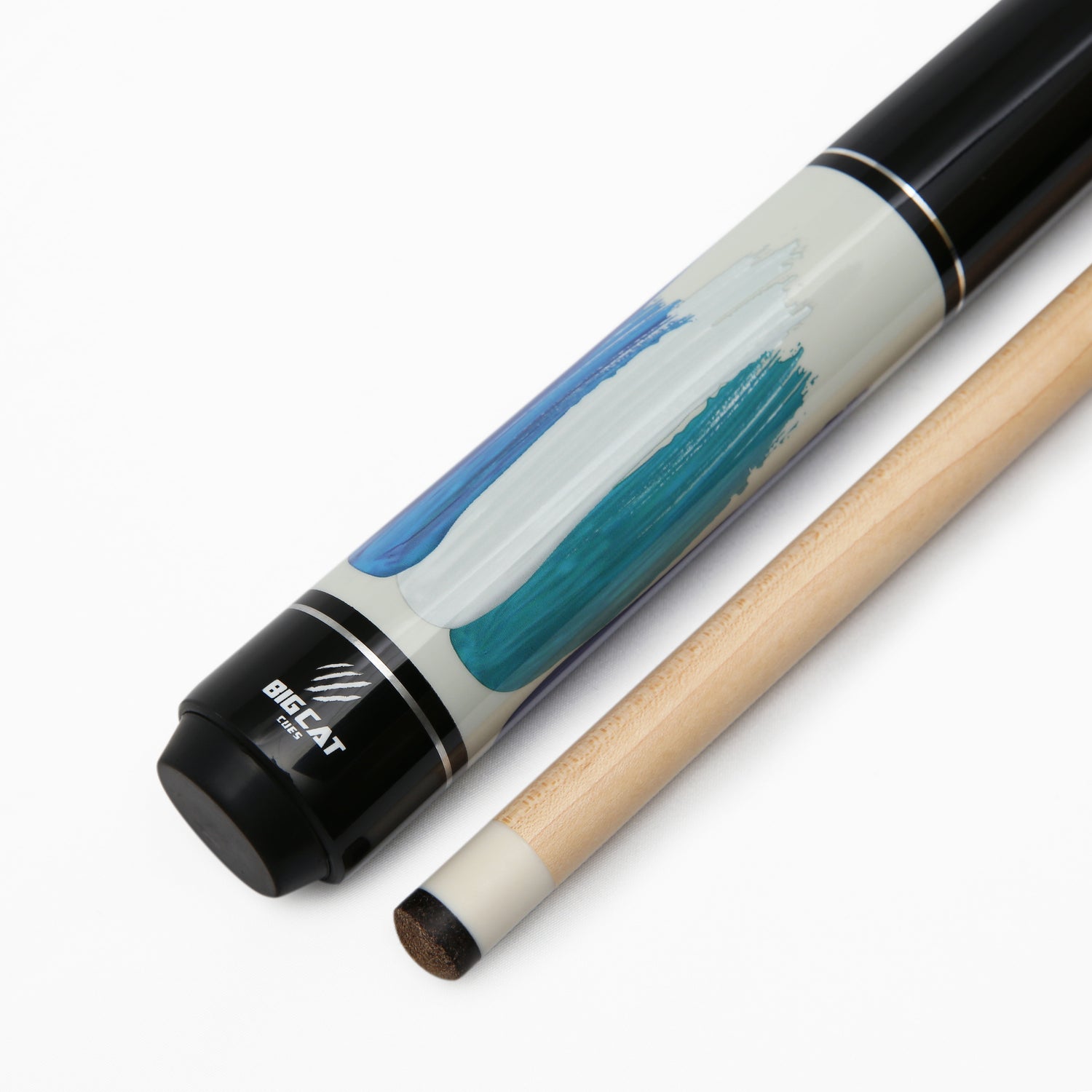
How To Play Pool? Guide For Beginners
With a blend of precision and strategy, billiards has been a beloved play for centuries. Among its various forms, pool stands out as a game that demands skill and a keen understanding of the rules. If you're a beginner eager to know how to play pool, this guide is what you need.
Before Starting
Before you even think about shooting your first ball, it's essential to familiarize yourself with the tools of the trade. Let's delve into the basics to prepare for your pool-playing journey.
Familiarize Yourself With Pool Equipment
- Pool Table: Rectangular in shape, it features six pockets – four in the corners and two in the middle of the long sides.
- Pool Balls: A standard pool game has 15 object balls, each numbered from 1 to 15. They are divided into two groups – solids (1 through 7) and stripes (9 through 15).
- Pool Cues: Typically made of wood, the cue stick features a sharp end known as the tip to strike the cue ball.
- Rack: The triangular frame is for setting up the opening position of the balls. How you rack pool balls will affect the outcome of the break.
- Chalk: The cue tip must maintain optimal friction with the cue ball to create spin and control. Chalking the end before each shot helps achieve this.
Learn The Language

Learning how to play pool for beginners starts by mastering the widely played 8-ball pool game. Here are some terms you should know before playing this exciting game:
- A cue's "balance point" refers to the spot along its length where it can be balanced horizontally.
- The "break" is the first shot, which occurs at the game's start when one player breaks up all the pool balls. Some break straight on, while others break at an angle.
- A "scratch" refers to the situation where the cue ball (the white ball) is pocketed into one of the pockets after a player takes a shot.
- "Bridge" refers to the hand placement and support stabilizing the cue stick during a shot. The bridge is a crucial element in achieving accuracy and control.
Explore The Rules Of Pool Games
After learning about terms, it's time to explore the rules of pool game. The objective of the 8-ball pool is clear: be the first to sink all your balls and then strategically pocket the elusive black 8-ball to claim victory.
Here is the step-by-step process and rules for this exciting game:
1. Set up the rack
Set up the rack
Use the triangle frame to "rack up" the 15 pool balls. While preferences may vary, ensure the 8-ball is in the middle for a standard setup.
2. Shoot the breakIf a player successfully pockets a ball during the break, they claim that type (solids or stripes) for the entire game and continue shooting. The opponent then takes the other set.
Meanwhile, if the breaker sinks at least one ball from both sets, they get to choose their preferred set.
3. Continue the game- Both players try to sink their balls until only the 8-ball remains. The one who successfully pockets the 8-ball first is the winner.
- When a player accidentally pockets one of their opponent's balls, it benefits the opponent.
- If a player unintentionally sinks the 8-ball before clearing their other balls, they lose the game.
- If a player scratches while shooting for the 8-ball, their turn ends, and it becomes their opponent's turn.
- When a player manages to pocket the 8-ball but subsequently scratches, they lose the game.
Should you be curious about other games like 9-ball, pocket billiards, and snooker, follow Big Cat to learn about their unique challenges and rules. Remember, precision and strategy play a significant role, so stay sharp, master the rules, and aim for victory.
Learn How To Hold And Move The Pool Stick

Hold and move the pool cue stick properly.
How you grip and control the cue stick is another factor that significantly impacts your shots. These essential hand placements will set you on the path to cue stick mastery:
|
Technique |
Hand Placement |
Use |
|
Open Bridge |
Place your hand on the table with your fingers spread. Slide the cue into the "V" between the thumb and index finger. Adjust hand arch for cue stick height. |
Provides stability and control, especially for longer shots. |
|
Closed Bridge |
Form a loose circle with thumb and index finger, allowing the cue stick to slide through the center. |
Offers a compact and stable bridge, suitable for precision shots and close-quarter play. |
|
Rail Bridge |
Position your hand on the rail or against its side. Slide the stick through the "V" between the thumb and index finger, then wrap the index finger over the cue stick for enhanced control. |
Ideal for shots requiring precision and control along the rail. |
|
Elevated Bridge |
Elevate palm off the table, placing pinky finger and index finger on the surface. Adjust the thumb to the desired height and slide the pool cue stick through the "V" between the thumb and index finger. |
Suitable when you need to clear obstructing balls or achieve a specific angle. |
|
Mechanical Bridge |
Place the bridge near the cue ball on the pool table. Slide the cue stick into one of the grooves on the bridge for optimal shot alignment. |
Ideal for shots that are challenging to reach or require a precise line-up. |
Before mastering these techniques, get yourself a suitable tool. Whether you choose the infamous Carbon Series, the classic Timeless Legacy Cues, or the innovative Paint Brush Line, they will help you achieve the best shots.
How To Play Pool?
Diving into the pool world is not just about knowing the rules. It's all about mastering the physical skills: stroke, shot, switch, and focus. Let's break down the essentials that elevate your gameplay:
Master The Stroke
If you're right-handed, grip the base of the cue stick with your right hand and rest the narrow end on your left. Lefties do the opposite.
- Create a solid hand position by curving your index finger on the stick and placing your thumb at the bottom. This tight grip ensures you have full cue control.
- Experiment with variations – some might prefer resting the cue on their index finger, while others might find a flattering style between their fingers best.
- Once you've settled on your preferred hand position, remember this hand stays steady. The only movement during a shot should come from your back arm.
- Stand with your feet wider than shoulder-width apart. Angle your feet at around 45 degrees for a stable and balanced stance.
- Tighten your grip on the cue stick during practice strokes for maximum control.
- Move your eyes between the contact point on the cue ball and the specific spot you're aiming for on the object ball.
Make The Shots
Now that you've got a grip on the stroke, it's time to line up your shots and make those crucial plays. It might sound easy, but mastering shots involves more finesse than meets the eye.
How do you play pool with effective shots? Start by aligning the pool tip with the cue ball, aim, and take your shot. For beginners, the initial focus should be hitting the cue ball straight and with enough power. It sets the stage for accurate shots and control.
Picture a direct hit on your object ball – that spot you'd target. Aim to get the cue ball precisely to that spot on your object ball. Visualization is a powerful tool for perfecting your aim.

Visualize your shots (Image Source: Billiards.com)
As you start making shots, consider experimenting with slow, easy shots. A softer touch allows your ball to ride the table's edge or strategically positioning it for a defensive play.
Take your time and try different shot intensities. Remember, each shot is a reflection of your skills and an inch closer to being a skilled pool player.
Switch it up
Once you've learned the basics of 8-ball, it's time to switch things up and explore other exciting variations of the pool. The pool world is diverse and offers a range of games to keep your skills sharp and the fun rolling.
- Cutthroat Pool: Players select a section of the numbers based on the number of players. The goal is to sink your opponent's balls while keeping yours on the table. The last player with remaining balls claims victory. It's a strategic battle that adds a new layer to your pool experience.
- 9-Ball: The objective is to sink the balls numerically from 1-9. Each player takes turns aiming for the 9 ball. The one who successfully pockets the 9-ball win. The best of 9-ball lies in its unpredictability – a player could sink balls 1-8 and still lose.
These variations add diversity to your pool experience and challenge your skills in various ways. Each game has its own strategies and thrills, ensuring that your pool journey remains engaging and dynamic.
Stay Focused
As you know how to play pool, focus is one of the most crucial factors for winning. Whether you're aiming for precision shots or strategizing your next move, maintaining concentration is crucial to success on the pool table.

Focus on the balls
Keep a laser-like focus on the ball you aim to hit. Tuning out distractions, such as background noise or movements, can significantly enhance your accuracy.
Further, confidence is a valuable asset, but avoid overconfidence. Similarly, frustrating moments are part of the game, but don't let them derail your focus. The tables turn swiftly, so keep a balanced mindset.
Finally, instead of solely seeking to win, focus on a better shot. Continuous improvement is a more sustainable and rewarding approach that will serve you well in the long run.
Playing Pool Tips
As you immerse yourself in the pool world, here are some invaluable tips to enhance your gameplay and upgrade your skills:
- Practice Regularly: Consistent practice is the key to improvement. Set aside dedicated time to improve your skills, refine your strokes, and try different techniques.
- Study Your Opponents: Observe how experienced players approach the game. Learning from others can provide valuable insights into strategies, shot selections, and game dynamics.
- Work on Cue Ball Control: Mastering cue ball control is crucial. Understanding how the cue ball reacts to different shots and practicing precise positioning will significantly enhance your gameplay.
- Have a Pre-shot Routine: Setting a Pre-shot Routine helps you maintain focus and consistency. It could involve visualizing the shot, taking a few practice strokes, and ensuring a steady stance before each play.
Final Thoughts
We hope the tips and techniques provided in this guide have helped you master how to play pool and enhance your skills on the pool table. Remember, each shot is an opportunity to refine your abilities, and each game is a chance to learn and grow. As you explore various pool games and experiment with strokes, the joy of playing pool will only deepen.
See more related articles:


